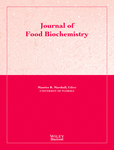ANTIOXIDANT ACTIVITY OF INONOTUS OBLIQUUS GROWN ON GERMINATED BROWN RICE EXTRACTS
Abstract
ABSTRACT
The aim of this study was to determine the antioxidant activity of different extracts from Inonotus obliquus (IO) grown on germinated brown rice by employing several established methods. The total phenolic and flavonoid contents were performed by Folin–Ciocalteau and aluminum chloride colorimetric assay, respectively. All the extracts showed strong antioxidant activity. However, the ethanol-based extract showed significantly highest antioxidant activity with the values of the half maximal inhibitory concentration (IC50) for 1,1-diphenyl-2-picryl-hydrazyl (DPPH), 2,2′-azino-bis(3-ethylbenzothiazoline-6-sulfonic acid) diammonium salt (ABTS), hydroxyl and superoxide radical scavenging activities were 16, 30, 45, and 100 µg/mL, respectively. In addition, the antioxidant activities of IO extracts were highly correlated with the observed total phenolic and flavonoid contents. Our study successfully demonstrates that the extracts from IO could be a potential source of antioxidant as a medicinal and dietary supplement.
PRACTICAL APPLICATIONS
Inonotus obliquus (IO) has been used as a medicine in many Asian countries. IO extracts build up immunity, treat influenza and other viral and bacterial infections, and improves skin elasticity. As a folk remedy, IO was taken in tea or powder form. Japanese scientists reported that topical use of IO helps combat the signs of aging. In Japan, it is used in creams to treat wrinkles. The water extract of IO has antitumor and antimicrobial activities. In addition, hot water extract from IO inhibits the cellular proliferation in cancer cell lines in human stomach. IO is regarded as a “functional food” and believed to promote longevity.




